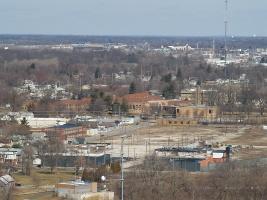Yesterday, I reported about Jeff Neumeyer’s story on Indiana News Center about the City asking President-elect Obama for $10 million to acquire and prepare the OmniSource property along Clinton Street. Â I have received a little more information about this. Â Here is part of the press release from the US Conference of Mayors, which was the impetus for the list:
The nation’s mayors today released the third installment of their Ready-to-Go Jobs Report that inventories infrastructure projects from cities around the country that could be started and completed in just two calendar years to create over a million jobs with help from federal dollars.
Today, mayors are reporting that in 641 cities of all sizes in all regions of the country, a total of 15,221 local infrastructure projects are “ready to go.” These projects represent an infrastructure investment of $96,638,419,313 that would be capable of producing an estimated 1,221,677 jobs in calendar years 2009 and 2010. These are the cumulative totals of projects, required funding, and jobs to be created that have been reported in the three surveys of cities conducted by the Conference of Mayors.
Mayors believe their plan responds to President-Elect Obama’s goal of creating 2.5 million jobs to spur the national economy.
[…] “This report contains examples of the kinds of projects that, if funded through existing channels, would contribute
significantly to the President-elect’s stated goals for infrastructure revitalization and job creation,” said U.S. Conference of Mayors President Miami Mayor Manny Diaz. “However, Mayors recognize that this list must go through a review process through which Congress and the new Administration will identify projects eligible for funding.”As an organization that represents mayors and their cities — which have their own local process for determining which projects are needed for jobs and economic development – the United States Conference of Mayors has accepted each city’s project submittal. Hence, each Mayor and City is responsible for its justification for putting these projects forward.
The mayors’ report combines the cumulative totals of projects, funding and jobs from the two surveys previously released by the Conference (November 14 and December 8) with this week’s survey information. Projects were sent to the Conference of Mayors from cities in all regions of the country and fall in ten different sectors:
• Community Development Block Grants
• City Street/Metro Roads
• Transit
• Green Jobs
• School Modernization
• Public Safety Jobs and Technology
• Public Housing Modernization
• Water and Wastewater Infrastructure
• Amtrak
• Airport TechnologyMayors have stressed that investing in MainStreet metropolitan economies, which comprise 90% of our gross domestic product and drive the national economy, is the most direct path to creating jobs and stimulating the business that can begin to reverse the current economic downturn. Mayors say metro infrastructure projects can start quickly because the funding for them can come directly to their cities through existing funding channels such as the Community Development Block Grant, which has been in place since the early 1970s and is considered to be a model for effective delivery of federal funds.
“As each month passes, we are reminded of the rapid deterioration of the long-term job outlook for Americans. Our metropolitan economies desperately need help at the Main Street level, and the mayors’ MainStreet Recovery plan is the answer,” said Tom Cochran, Conference CEO and Executive Director.
You can see a list of Fort Wayne’s submitted projects here. Â I would encourage you to spend some time looking at the list. Â It does list the OmniSource Property acquisition as:
Property Description: North River Development (Acquisition, Brownfield Site Prep., Infrastructure)
Funding Required: $10,000,000
Jobs Created: 80Â
So, this explains the source of the story, but does not explain the breakdown of the $10 million. Â
The totals for the Fort Wayne list are $282 million in projects creating 3,339 jobs which averages out to about $85k spent per job created.  For comparison purposes, Carmel, Indiana’s list totals $120 million with 3,461 jobs created for an average of $35k spent per job created.  Indianapolis’ list totals $268 million with 1,181 jobs created for an average of $226,932k spent per job created.  I’ll admit I’m not spending lot of time with this as I have other pressing matters.  I will say that I looked at some smaller and some larger cities and when you look at the amount spent per job created, the smaller cities seem to get, on the 10 or so I checked, better bang for the buck.  I will be doing some research and checking into some of this a bit further when time allows.
I am a bit chagrined and think the list should have contained some sort of ranking system for the projects so that a Federal official could make a better decision. Â For instance, if we were granted money towards the OmniSource acquisition, would that money be better spent on reducing the City’s upcoming CSO project? Â Which would have the greater impact? Â The only other thing I’ll say at this point, is that Neumeyer really should have done a bit more follow-up on that $10 million figure to see exactly why and how City officials came up with that figure. That’s quite a thing to throw out there and not explain. Â He also should have stated how the list came together and the name of the organization the list. Â At the least, a link to the list could/should have been supplied.
